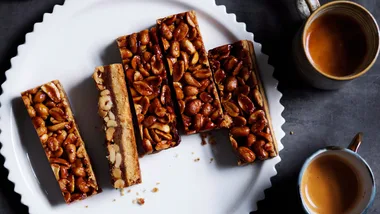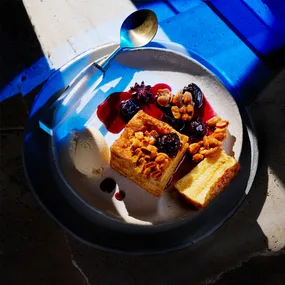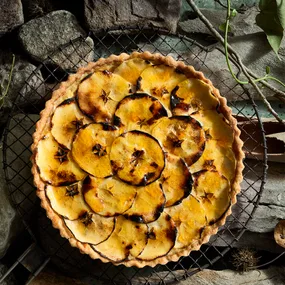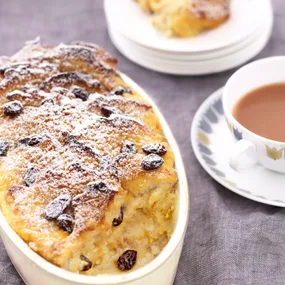Prepare to be happy. This layered chocolate mousse cake has a lovely texture and rich chocolate flavour, yet is simple to make. The beauty of it is that it can also be made ahead and frozen in preparation for a special occasion.
The cake base
For the cake base, I like to use a roulade sponge – it has no fat content so it can be refrigerated without becoming hard, and it has a lovely light texture that balances well with mousse. Whisk the yolks and some of the sugar in an electric mixer on medium speed, being careful not to overwhisk or the sponge will be dense; this goes for whisking the eggwhites, too – just whisk them till they hold stiff peaks. When folding the eggwhites into the yolks, and then the cocoa-cornflour mixture, fold the mixture just until everything is incorporated to reduce the loss of aeration. And sieve your cocoa and cornflour first to avoid any lumps.
To give the cake base a richer flavour, brush it liberally with a simple light sugar syrup with an added liqueur of your choice; I like Grand Marnier, a classic pairing with chocolate. Do the brushing when both the syrup and sponge are cool. The syrup not only introduces another flavour, but it also helps to prevent the sponge drawing moisture out of the mousse, which would cause it to dry out and shrink.
The mousse
Next comes the mousse. There are many ways to make chocolate mousse, but this method is my favourite – the secret is to use whipped cream, which aerates the mixture, resulting in a beautiful texture that melts in your mouth, while the flavour is nicely rounded and not too sweet. The important factors are the fat, or cream, and the type of chocolate, of course. You cannot interchange the chocolate in this recipe – there is a fine balance of liquid to chocolate. If you use a chocolate with a percentage higher or lower than 53 per cent cocoa solids the mousse won’t have the best texture. With a lower content it will not set properly, and as you go higher the mousse will become firmer and eventually split and have a terrible texture.
When you’re mixing the mousse it’s most important to form a good emulsion when you add the syrup and the initial quantity of cream to the chocolate; otherwise it won’t set properly. Once the syrup has been incorporated you should have a smooth, shiny, slightly elastic emulsion; before adding the cream, whip it to just before soft peaks form.
An emulsion is the combining of two ingredients that don’t normally combine, fat and liquid. This is key to achieving a smooth, creamy texture, and it enhances the true taste of the chocolate. If the emulsion is not achieved, the mix becomes unstable and when the remaining whisked cream is folded into the chocolate, the two don’t combine properly. If you’re mixing by hand, mix energetically with small circular movements in the centre of the mixture to ensure the fat and water become homogenous, which stabilises the mixture; visually it will be elastic and shiny. Generally, if you’re using a stick blender it will emulsify well.
The icing
The icing is straightforward; use it when it has cooled but is still fluid. Once the mousse has set in the fridge for at least six hours, pour the icing on top while it’s in the ring and tilt it to cover the entire surface. At this point the cake can be frozen (for up to a month); defrost it in the fridge when you’re ready to serve it.
Once the icing has set, remove the ring. If you’re using a deep metal ring or springform tin, gently heat the outside with a blowtorch until it easily slips off the cake; or run a hot knife around the inside of the ring, then refrigerate the cake again to firm it up. If you’re using acetate sheets, as we have here, just peel them away from the cake; no heat is required. Acetate sheets are great for creating a higher mould; just cut them to your desired height and line the inside of the mould.
We’ve decorated the cake with chocolate curls; you could also use roasted nuts, praline or berries. Or coat the cake completely in chocolate. Spray a fine mist of canola spray onto a bench and put a piece of plastic wrap large enough to cover the cake on top, smoothing it out to remove all the creases. Pour melted chocolate in the centre, then spread it with a palette knife into a disc large enough to cover the top and sides of the cake. The chocolate only needs to be 2mm-3mm thick. Have the cake close to you then pick up the plastic wrap by the corners furthest away and place it chocolate-side down on the cake, ensuring it hangs down to cover the sides. Smooth down the sides and run a small knife around the base of the cake to form a neat edge. Refrigerate it for at least 10 minutes or until you’re ready to serve, then simply peel off the plastic wrap and decorate it.
To serve, use a warm knife to cut the cake and don’t leave it sitting at room temperature for long, or it will soften. I serve it with crème Chantilly (whipped cream sweetened with icing sugar and vanilla) – it’s billowy and perfect with the lush mousse.
Ingredients
Method
Acetate sheets are available from art-supply shops, such as riotstores.com.au
Notes









